EPoX EP-5P945 PRO: Budget 945P Performance
by Gary Key on September 11, 2006 4:45 AM EST- Posted in
- Motherboards
Features and Layout
EPoX designed a well laid out board with all major connections easily reached. The layout provides very good clearance for all cards and most components and was very easy to install in our mid-size ATX case. The board features a well-designed 4-phase voltage regulator power design that provided superb stability during general usage and light overclocking. EPoX installed a combination of solid state capacitors along with high quality Sanyo electrolyte capacitors.
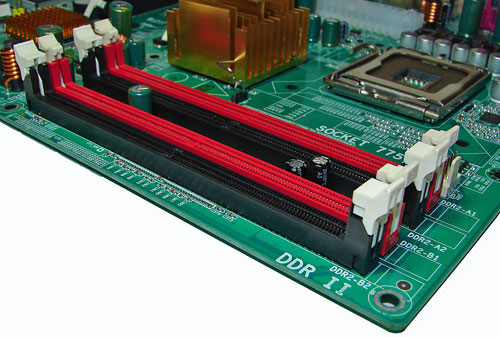
The DIMM module slots' color coordination is correct for dual channel setup. The memory modules are easy to install with a full size video card placed in the primary PCI Express X16 slot.
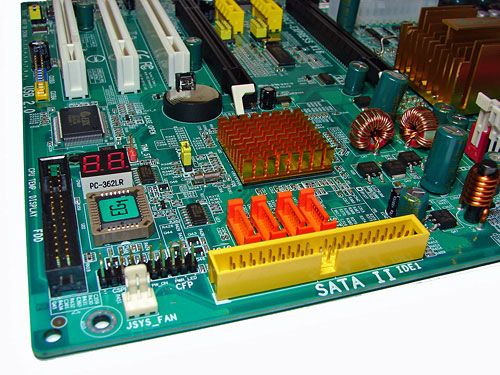
The orange ICH7 SATA ports are conveniently near the board's edge and in front of the to the yellow IDE port connector. Unlike other recently reviewed boards the SATA ports are not color coded for primary and secondary operation if this is important to you. We found the positioning of the SATA ports to be excellent when utilizing the PCI slots or the single IDE port connector. The Intel ICH7 chipset is passively cooled with a low-rise heatsink.
The yellow IDE connector did not present any connection issues in our mid-size ATX test case. The location of this connector is very good for most cases and those users still utilizing IDE hard drives, though most will use it for an optical drive(s) instead. The chassis panel and system fan header are located on the left of the drive ports. The black floppy drive connector is located in an inconvenient position at the left edge of the board. The CP80P post port debug LED is to the right of the floppy drive connector and in front of the EPoX EG1 I/O controller chip. The two USB 2.0 headers are located on the left edge of the board next to the last PCI slot.
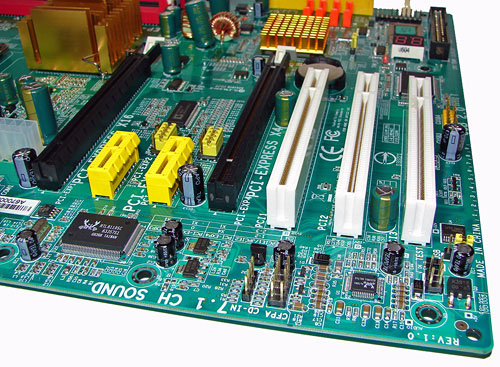
The board comes with two physical PCI Express X16 connectors, two PCI Express X1 connectors, and three PCI 2.3 compliant 32-bit connectors. The layout of this design offers an exceptional balance of expansion slots for a full size ATX board.
Returning to the CPU socket area, we find a limited amount of room for alternative cooling solutions. We utilized the stock Intel heatsink and heatsinks such as the Cooler Master X-Dream P775 that utilize the same footprint size as the retail unit without issue. However, we verified our Tuniq 120 Tower and Scythe Infinity would not fit properly in this area during our tests due to the close proximity of the 945P MCH heatsink. We doubt most users of this board would go to that extreme to cool the processor due to the limited overclocking capabilities of the board.
Our other fitment concern is the location of the 24-pin ATX power connector as the cabling tends to interfere with the CPU heatsink/fan during usage. EPoX places the four-pin ATX power connector next to the 24-pin ATC connector. The cabling to this connector proved difficult to install if the main power cable was already attached.
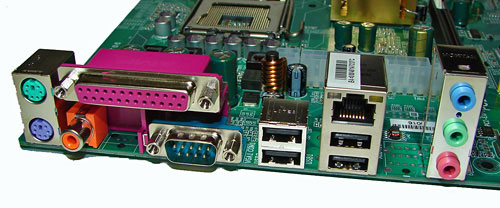
The PS/2 mouse and keyboard ports are located to the left of the LPT parallel port, 9-pin serial port, and S/PDIF Coaxial port. The first two USB 2.0 ports are located next and are followed by the LAN (RJ-45) port and the second pair of USB 2.0 connectors. The audio panel consists of 3 ports that can be configured for 2, 4, and 6-channel audio connections.
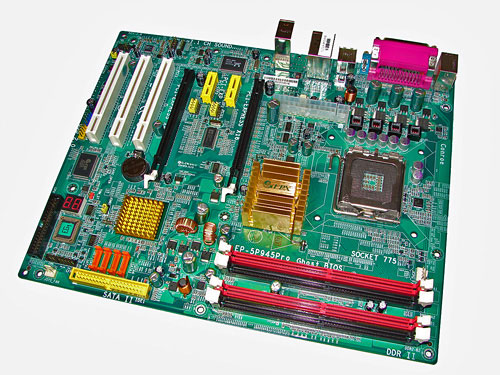 |
| Click to enlarge |
EPoX designed a well laid out board with all major connections easily reached. The layout provides very good clearance for all cards and most components and was very easy to install in our mid-size ATX case. The board features a well-designed 4-phase voltage regulator power design that provided superb stability during general usage and light overclocking. EPoX installed a combination of solid state capacitors along with high quality Sanyo electrolyte capacitors.

The DIMM module slots' color coordination is correct for dual channel setup. The memory modules are easy to install with a full size video card placed in the primary PCI Express X16 slot.

The orange ICH7 SATA ports are conveniently near the board's edge and in front of the to the yellow IDE port connector. Unlike other recently reviewed boards the SATA ports are not color coded for primary and secondary operation if this is important to you. We found the positioning of the SATA ports to be excellent when utilizing the PCI slots or the single IDE port connector. The Intel ICH7 chipset is passively cooled with a low-rise heatsink.
The yellow IDE connector did not present any connection issues in our mid-size ATX test case. The location of this connector is very good for most cases and those users still utilizing IDE hard drives, though most will use it for an optical drive(s) instead. The chassis panel and system fan header are located on the left of the drive ports. The black floppy drive connector is located in an inconvenient position at the left edge of the board. The CP80P post port debug LED is to the right of the floppy drive connector and in front of the EPoX EG1 I/O controller chip. The two USB 2.0 headers are located on the left edge of the board next to the last PCI slot.

The board comes with two physical PCI Express X16 connectors, two PCI Express X1 connectors, and three PCI 2.3 compliant 32-bit connectors. The layout of this design offers an exceptional balance of expansion slots for a full size ATX board.
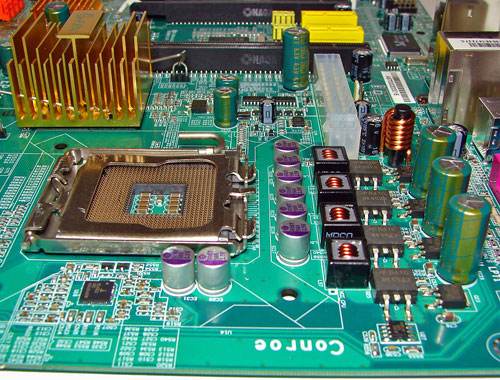 |
| Click to enlarge |
Returning to the CPU socket area, we find a limited amount of room for alternative cooling solutions. We utilized the stock Intel heatsink and heatsinks such as the Cooler Master X-Dream P775 that utilize the same footprint size as the retail unit without issue. However, we verified our Tuniq 120 Tower and Scythe Infinity would not fit properly in this area during our tests due to the close proximity of the 945P MCH heatsink. We doubt most users of this board would go to that extreme to cool the processor due to the limited overclocking capabilities of the board.
Our other fitment concern is the location of the 24-pin ATX power connector as the cabling tends to interfere with the CPU heatsink/fan during usage. EPoX places the four-pin ATX power connector next to the 24-pin ATC connector. The cabling to this connector proved difficult to install if the main power cable was already attached.

The PS/2 mouse and keyboard ports are located to the left of the LPT parallel port, 9-pin serial port, and S/PDIF Coaxial port. The first two USB 2.0 ports are located next and are followed by the LAN (RJ-45) port and the second pair of USB 2.0 connectors. The audio panel consists of 3 ports that can be configured for 2, 4, and 6-channel audio connections.










23 Comments
View All Comments
Zoomer - Monday, September 18, 2006 - link
While anandtech regularly bashes ATi/nVidia for paper launches, wouldn't this be a paper launch too? I can't find it for sale on the egg nor any other site.Gary Key - Wednesday, September 27, 2006 - link
I have contacted EPOX about supply, we purchased a retail board from NewEgg for comparison but according to our sources they do not have a firm delivery date so the board was pulled until an ETA is available.
Stele - Wednesday, September 13, 2006 - link
By the way, another noteworthy point of this review is the superb photography used. The level of detail and focus are excellent, and furthermore there is sufficient, white ambient lighting used so that the board isn't covered in off-colour shadows as if it were photographed under a sofa in the evening or something....While some people would dismiss the quality of motherboard photography as a non-issue, for some of us it's important to be able to see up close and gauge at least the layout of various components, connectors etc (better still if we could even see the details of certain components, as was very much the case in this review) without having to actually find a real sample of the board.
Stele - Tuesday, September 12, 2006 - link
Good review, as can be expected from Anandtech :)However, I would just like to point out a little misnomer that's becoming distressingly popular on the web... those little bare-metal capacitors are not called "solid state capacitors". They are, in fact, just aluminium electrolytic capacitors. The difference is that generally, the electrolyte used is of a solid type, rather than the liquid electrolyte the 'traditional' aluminium electrolytic capacitors contain.
Hence, if you want to differentiate them from the 'traditional' electrolytic capacitors, you could perhaps call them 'solid electrolytic capacitors' but certainly not 'solid state'... that is an old term used to describe circuits that do not use vacuum tubes, during the advent of transistors.
yyrkoon - Wednesday, September 13, 2006 - link
Suface mount, according to an EE buddy of mine.Stele - Wednesday, September 13, 2006 - link
I agree with him perfectly. As much as he's right if he were to call the components in question 'capacitors'. :)
Surface mount just means it's soldered onto the surface of the motherboard's PCB rather than using the traditional thin 'legs' that poke through holes in the PCB (such a component and mounting technology are called 'through-hole'). As such, while surface mount is an accurate description of the capacitors, it describes another aspect of the components in question altogether :)
However, because it is an accurate description nevertheless, calling these capacitors 'surface mount' is therefore actually more accurate than calling them 'solid state' ;) Yet the point reviewers are trying to make is not so much that the capacitors are surface-mount, but that they are not the traditional liquid electrolytic type that are more prone to leakage and failure under prolonged exposure to harsh operating evironments (thermally and electrically). Hence, the focus is more on the electrolyte type - solid vs. liquid - rather than surface-mount vs. through-hole.
blckgrffn - Monday, September 11, 2006 - link
I appreciate this timely review. I was trying to decide whether the GF was a getting a x2 or a Core Duo, and this board is going to solve my dillema.If only they had stuck the ICH7R or even just a 2 or 4 port SATA raid controller on there, as the lack of raid is really bogus now. A lot of my customers/friends want RAID1 for redundancy. I know this can be done in software, but hardware raid is much more transparent.
This board would be a no brainer if it included RAID.
Thanks again,
Nat
yyrkoon - Monday, September 11, 2006 - link
Well, of course I cannot speak for you, or anyone else, but in my opinion, RAID 1 is a bad idea for anyone who is likely to muck up a system. I find that non RAID (possibly USB drive backups, or whatever else you preffer), are often better, and have greater flexability. Another thing to note, is that if Windows isnt nessisary, Linux / BSD RAID 0,RAID 1 is nearly, if not just as fast as Hardware RAID. Also, incremental ghosting of a system drive is another option which is much more flexable.Basicly, the only real reason for RAID 1, is in the event of hardware failure, and if you purchase with this in mind, there is no reason why a HDD cant live for 5-8 years easily.
blckgrffn - Monday, September 11, 2006 - link
Try telling users with 100's of gigs of photos or videos that there HD should have lasted 5 years, not 5 months. I have already been there and it isn't comfortable. There is a reason dell is offering RAID 1 on nearly every desktop model they have. It's the easiest, most transparent way to send your MTBF into the stratosphere.Second, my $80 EVGA SLI mobo has all those features, as do many AMD catered motherboards. In the past, Intel boards have also come down to reasonable levels.
I stoutly refuse to spend more on a mobo than a processor, sorry. And I am not paying $150 for a board that has been gutted of features expected of a high to medium end motherboard.
Nat
yyrkoon - Monday, September 11, 2006 - link
And yes, we run a PC buisness here also, and have yet to see a HDD reguardless of how bad off, that we couldnt pull the data off. Most of the time, you just put the drive in another machine, pull the data off, and thats that. Once in a blue moon you have to send the drive off to have a company equiped with the hardware to get at the data, but that is extremely rare. RAID 1 wont work for an accidental deletion, and the like, thats where its the buisness owners responcability to educate average PC users for each situation, and not just try to make a quick 10%-15%(on a HDD) by selling another drive.